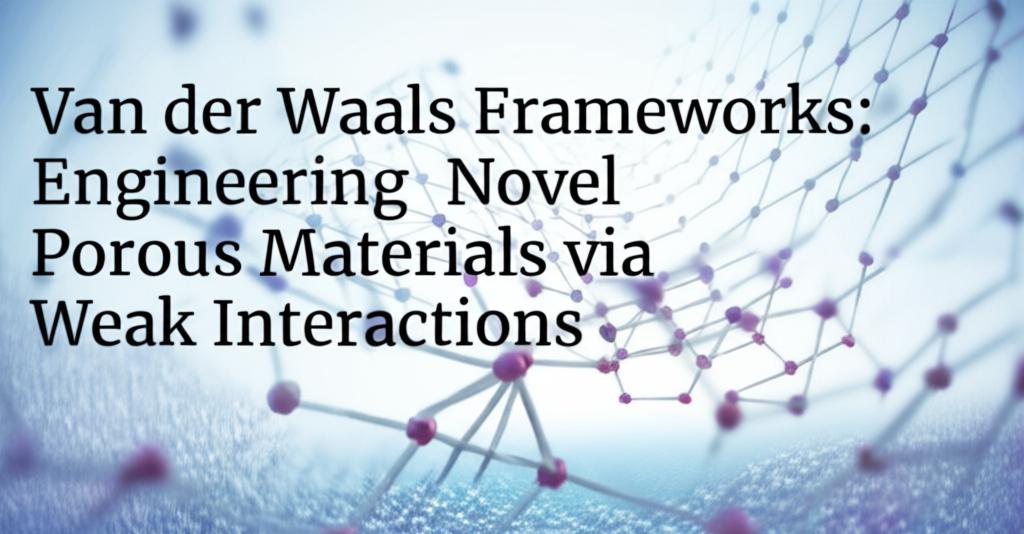Van der Waals (vdW) frameworks represent a fascinating and rapidly evolving class of porous materials. Traditionally, the construction of robust, porous frameworks relied on strong covalent or coordination bonds, as seen in materials like Covalent Organic Frameworks (COFs) and Metal-Organic Frameworks (MOFs). It was generally believed that the comparatively weak and non-directional nature of van der Waals interactions – which include London dispersion forces, dipole-dipole interactions, and hydrogen bonds (though sometimes categorized separately) – made them unsuitable for creating stable, open, and porous structures. However, recent breakthroughs are challenging this long-standing assumption, demonstrating that careful design and engineering can harness these subtle forces to produce novel materials with remarkable properties.
A significant advancement in this field, published in early 2024, showcases the development of the first three-dimensional van der Waals open frameworks (WaaFs). Researchers at Kyoto University demonstrated that by using precisely designed molecular building blocks, specifically octahedral metal-organic polyhedra (MOPs) larger than 2 nanometers, stable and highly porous 3D structures can be assembled primarily through vdW interactions. These MOPs, with their well-defined, large, planar aromatic faces, increase the intermolecular contact area, thereby significantly enhancing the cumulative strength of the vdW forces – achieving interaction energies comparable to some stronger bonds found in MOFs and COFs when many atoms are involved.
These WaaFs exhibit impressive characteristics. They can achieve high thermal stability, remaining intact at temperatures up to 593 K (320 °C). Furthermore, they boast exceptionally large specific surface areas, in some cases exceeding 2,000 m²/g. This high porosity is crucial for applications such as gas storage and separation. A key advantage of WaaFs is their potential for reversible assembly and disassembly in solution. This characteristic not only aids in their synthesis and processing but also opens doors for scalability and recyclability, which are critical considerations for industrial applications.
The implications of this research are significant. It redefines the design principles for porous materials, highlighting a new pathway that leverages weak interactions to achieve robust and functional architectures. The tunable porosity and chemical stability of WaaFs make them promising candidates for a diverse range of applications, including:
- Gas Storage and Separation: Their high surface area and tunable pore sizes are ideal for selectively adsorbing and storing gases like hydrogen, methane, or carbon dioxide, which is crucial for energy applications and carbon capture technologies.
- Catalysis: The porous nature can provide confined spaces for catalytic reactions, potentially enhancing selectivity and efficiency.
- Water Harvesting: Materials with tailored pore environments could be designed to efficiently capture water vapor from the atmosphere.
- Sensors: The interaction of guest molecules within the vdW framework could lead to detectable changes in material properties, forming the basis for chemical sensors.
While 3D WaaFs represent a major leap, research into 2D vdW frameworks and heterostructures also continues to advance. These layered materials, where individual sheets are held together by vdW forces, exhibit unique electronic, optical, and mechanical properties. Understanding and controlling the interlayer interactions in these 2D systems is key to tuning their functionalities for applications in electronics, optoelectronics, and catalysis. Methods for preparing 2D vdW materials include mechanical exfoliation, liquid-phase stripping, and various vapor deposition techniques.
Porous organic molecular materials, a broader category that includes hydrogen-bonded organic frameworks (HOFs) and porous organic cages (POCs), also rely on weak non-covalent interactions. These materials offer good solution processability, making them suitable for fabricating membranes for gas separation, ion separation, water treatment, and desalination. HOFs, in particular, utilize hydrogen bonds, often in conjunction with π-π stacking and other vdW forces, to create their porous structures. While achieving stability can be challenging due to the weaker nature of these bonds compared to covalent bonds, strategies like designing rigid building blocks, promoting framework interpenetration, and incorporating multiple hydrogen bonds are being employed to enhance their robustness.
Challenges and Future Directions:Despite the exciting progress, challenges remain in the field of vdW frameworks. For 2D materials, controlling the aggregation and stacking of individual layers while maintaining desired properties is an ongoing area of research. For 3D WaaFs and other porous materials based on weak interactions, ensuring long-term structural integrity under various operational conditions (e.g., pressure, temperature, chemical exposure) is crucial. The precise prediction and control of framework assembly, especially for complex multicomponent systems, also require further development in both theoretical understanding and synthetic methodologies.
Future research will likely focus on:
- Designing novel building blocks: Exploring a wider range of molecular components with tailored geometries, sizes, and surface functionalities to create vdW frameworks with precisely controlled pore environments and properties.
- Understanding structure-property relationships: Further elucidating how the subtle interplay of weak interactions dictates the final structure and performance of these materials.
- Advanced characterization techniques: Developing and applying methods to accurately visualize and quantify weak interactions within these frameworks.
- Exploring new applications: Expanding the use of vdW frameworks into emerging areas like biomedical applications (e.g., drug delivery), advanced separation processes, and novel electronic devices.
- Improving stability and processability: Developing strategies to enhance the mechanical and chemical stability of these materials, particularly HOFs, and to make their synthesis and processing more efficient and scalable.
In conclusion, the engineering of porous materials through van der Waals interactions is a rapidly expanding frontier in materials science. Recent breakthroughs have firmly established that these traditionally overlooked weak forces can be strategically harnessed to create highly stable and porous frameworks with significant potential for a wide array of practical applications. As our understanding and control over these delicate interactions continue to grow, vdW frameworks are poised to offer innovative solutions to many contemporary challenges in energy, environment, and technology.

